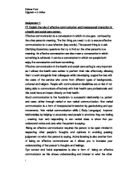Effective verbal communication in a health and social care setting allows the health care workers to perform their roles effectively
P1 – Interpersonal communication is a process of people exchanging information, feelings and meaning through verbal and non-verbal communication. Verbal communication is speech, texting and e-mails. Non-verbal communication refers to the messages that we send without using words; we send messages by tone of voice, facial expressions, hand and arm gestures, the way we sit and the tension within our body. In interpersonal interaction effective communication is vital. It helps us to understand a person or situation, to resolve differences and to build trust and a relationship with that person.
Effective verbal communication in a health and social care setting allows the health care workers to perform their roles effectively. It allows them to communicate well with their colleagues; which is extremely important as for example, if the service user is on medication they can exchange the information efficiently via spoken communication or e-mail. It is also valuable for the health care workers and service users to develop relationships, trust and to ensure confidentiality. The service users may be people who come from different types of backgrounds, cultures or religion, therefore each health care worker should have a holistic point of view and not judge.
Non-verbal communication is a form of interpersonal interaction and is relevant when working in a health and social care setting, within a few seconds of seeing someone you may be able to tell how they are feeling by their body language. It can tell the health care worker a lot about their client. The way your posture is when you sit or stand can send a message, if the client is sat slouched with their arms crossed it usually means they do not want to be there and they are not interested. As well as posture, the way in which you face a person can also communicate a message, when telling a child off you would face them straight on, this is seen as an angry angle to face someone however, a slight angle can create a more relaxed and friendly feeling. Gestures are hand movements and arm movements these are used during verbal communication or on its own, this may be used from a service user to a health care worker by putting their thumbs up to reassure they are ‘OK’ and various other gestures can be used. A facial expression indicates someone’s emotional state. When service user is a regular one, you may see different facial expressions, after the worker becomes familiar with that person they will be able to understand how they are feeling by their facial expressions. Some people can hide how they feel by smiling when they feel sad therefore sometimes facial expressions are hard to identify. We can guess how another person is feeling by the look in their eyes. Our eyes get bigger when we are excited or interested, this can show carers and service users straight away how one another is feeling. There are other types of non-verbal communications such a, touch, silence, tone of voice and proximity. It is important that a health care worker can identify some of these types of communications as it tells you a lot about the person, if someone is silent, not engaging in conversation, has their arms crossed, not using eye contact and look sad, they could be going through depression or being bullied, reading the non-verbal signs can be a lot more important that speaking.








